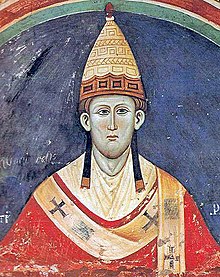Sun and Moon allegory

The Sun and Moon allegory is used to depict a
Description
Finding this imagery in the
LETTER OF INNOCENT III re-affirming primacy of the Pope's authority over civil powers. November 3, 1198:
To the noble man Acerbus and to the other leaders of Tuscany and of the Duchy.
Just as God, founder of the universe, has constituted two large luminaries in the firmament of Heaven, a major one to dominate the day and a minor one to dominate the night, so he has established in the firmament of the Universal Church, which is signified by the name of Heaven, two great dignities, a major one to preside--so to speak--over the days of the souls, and a minor one to preside over the nights of the bodies. They are the Pontifical authority and the royal power. Thus, as the moon receives its light from the sun and for this very reason is minor both in quantity and in quality, in its size and in its effect, so the royal power derives from the Pontifical authority the splendour of its dignity, the more of which is inherent in it, the less is the light with which it is adorned, whereas the more it is distant from its reach, the more it benefits in splendour. Both these powers or leaderships have had their seat established in Italy, which country consequently obtained the precedence over all provinces by Divine disposition. And therefore, as it is lawful that we should extend the watchfulness of our providence to all provinces, we must especially and with paternal solicitude provide for Italy where the foundation of the Christian religion has been set up and where the pre-eminence of the priesthood and kingship stands prominent through the primacy of the Apostolic See.
We therefore admonish and exhort you all in the Lord through this Apostolic letter, enjoining that since you receive a true and firm assurance from us who--as it is fitting for the Apostolic dignity--intend to do more for you than we want to promise, you should always endeavour to act in a way which would add to the honour and growth of the Roman Church so as to deserve and strengthen the pledge of her favour and friendship.[2]
In 1215, this concept was reflected in Canon 3 of the
...if a temporal ruler, after having been requested and admonished by the Church, should neglect to cleanse his territory of this heretical foulness, let him be excommunicated by the metropolitan and the other bishops of the province. If he refuses to make satisfaction within a year, let the matter be made known to the supreme pontiff, that he may declare the ruler's vassals absolved from their allegiance and may offer the territory to be ruled by Catholics, who on the extermination of the heretics may possess it without hindrance and preserve it in the purity of faith; the right, however, of the chief ruler is to be respected as long as he offers no obstacle in this matter and permits freedom of action.[3]
While this theory of papal sovereignty in temporal as well as spiritual matters was, by the fourteenth century, generally rejected as out-of-date,
References
Bibliography
See also
- Dante Alighieri
- De Monarchia
- Giles of Rome
- Papal supremacy
- Pope Boniface VIII
- Pope Innocent III
- Unam Sanctam
